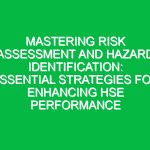In the realm of Health Safety and Environment (HSE), ensuring the safety and well-being of employees is paramount. One of the critical aspects of workplace safety is the monitoring of air quality and the detection of hazardous gases. With the advancement of technology, there are now more sophisticated methods and strategies to ensure that the air in the workplace is safe to breathe. In this article, we will delve into the advanced strategies for gas detection and air quality monitoring that can be implemented to maximize safety in the workplace.
Understanding the Importance of Gas Detection and Air Quality Monitoring
Before we explore the advanced strategies, it’s crucial to understand why gas detection and air quality monitoring are essential components of workplace safety. Hazardous gases, such as carbon monoxide, hydrogen sulfide, and volatile organic compounds (VOCs), can pose significant health risks to employees. Prolonged exposure to poor air quality can lead to respiratory issues, chronic illnesses, and even fatalities. Therefore, implementing robust monitoring systems is not just a regulatory requirement but a moral imperative for employers.
Advanced Gas Detection Technologies
Smart Sensor Technology
Modern gas detectors are equipped with smart sensor technology that offers enhanced sensitivity and faster response times. These sensors can detect a wide range of gases at lower levels, providing early warnings and allowing for prompt corrective actions. Smart sensors are also capable of self-calibration and diagnostics, ensuring consistent performance and reliability.
Wireless Gas Detection Systems
Wireless gas detection systems offer flexibility and scalability in monitoring air quality across large facilities. By eliminating the need for extensive wiring, these systems can be easily deployed and reconfigured as the workplace layout changes. Real-time data transmission allows for centralized monitoring and immediate response to potential gas leaks or air quality issues.
Internet of Things (IoT) Integration
The integration of IoT technology in gas detection devices enables a connected network of sensors that can communicate with each other and with central control systems. This connectivity allows for comprehensive data analysis, predictive maintenance, and automated alerts that enhance the overall safety of the workplace.
Effective Air Quality Monitoring Practices
Continuous Monitoring and Data Logging
Continuous monitoring of air quality is essential to detect any deviations from safe levels. Advanced monitoring systems can record and log data over time, providing valuable insights into air quality trends and helping to identify potential sources of contamination.
Portable and Fixed Monitoring Solutions
Employing a combination of portable and fixed monitoring solutions ensures comprehensive coverage of the workplace. Portable detectors can be used for spot checks and in areas where fixed systems are not feasible, while fixed monitors provide constant surveillance in critical zones.
Use of Multi-Gas Detectors
Multi-gas detectors are capable of monitoring several gases simultaneously, which is particularly useful in workplaces with a variety of potential gas hazards. These detectors streamline the monitoring process and reduce the need for multiple single-gas detectors.
Implementing a Robust Air Quality Management Plan
Regular Maintenance and Calibration
To ensure the accuracy and effectiveness of gas detection and air quality monitoring equipment, regular maintenance and calibration are necessary. A schedule for routine checks and servicing should be established and strictly followed.
Employee Training and Awareness
Employees should be trained on the importance of air quality and gas detection, as well as the proper use of monitoring equipment. Awareness programs can empower employees to recognize potential hazards and take appropriate actions.
Emergency Response and Evacuation Procedures
A well-defined emergency response plan should be in place in case of a gas leak or air quality incident. This plan should include evacuation procedures, communication protocols, and first-aid measures to ensure the safety of all employees.
Regulatory Compliance and Best Practices
Adhering to local and international regulations is crucial for legal compliance and the protection of employees. Employers should stay informed about the latest HSE guidelines and best practices for gas detection and air quality monitoring to maintain a safe workplace.
Summary of Key Points
In conclusion, maximizing safety in the workplace through advanced strategies for gas detection and air quality monitoring is essential for the well-being of employees. By understanding the importance of these measures and implementing smart sensor technology, wireless systems, IoT integration, and effective monitoring practices, employers can create a safer work environment. Regular maintenance, employee training, and adherence to regulatory standards further ensure that air quality risks are managed effectively. By prioritizing the health and safety of workers, businesses can foster a culture of safety and responsibility that benefits everyone involved.


